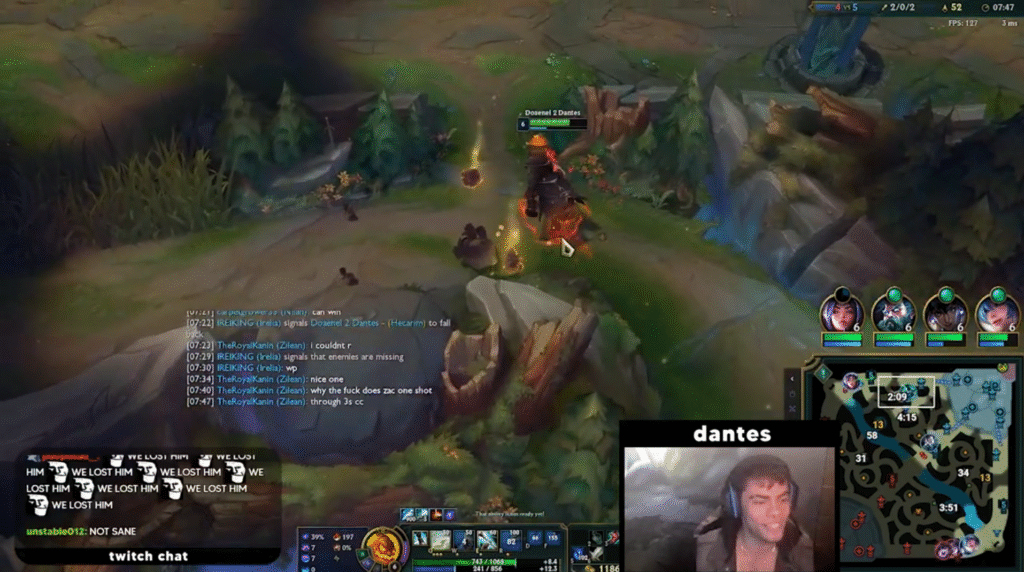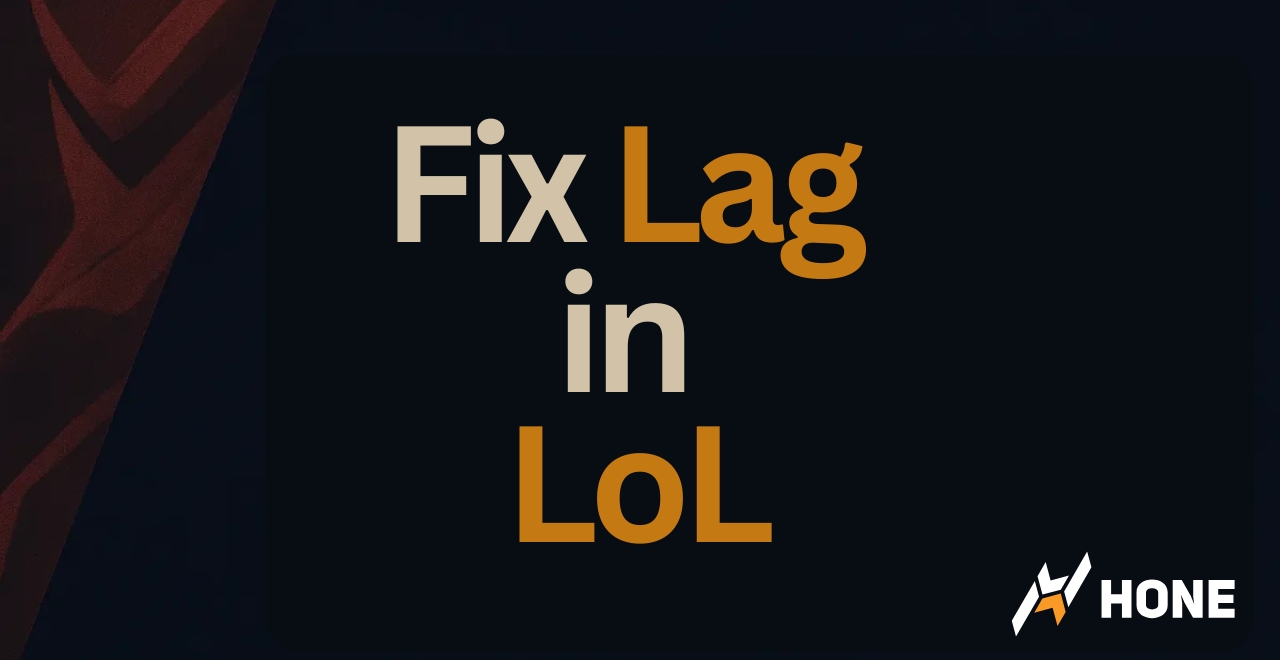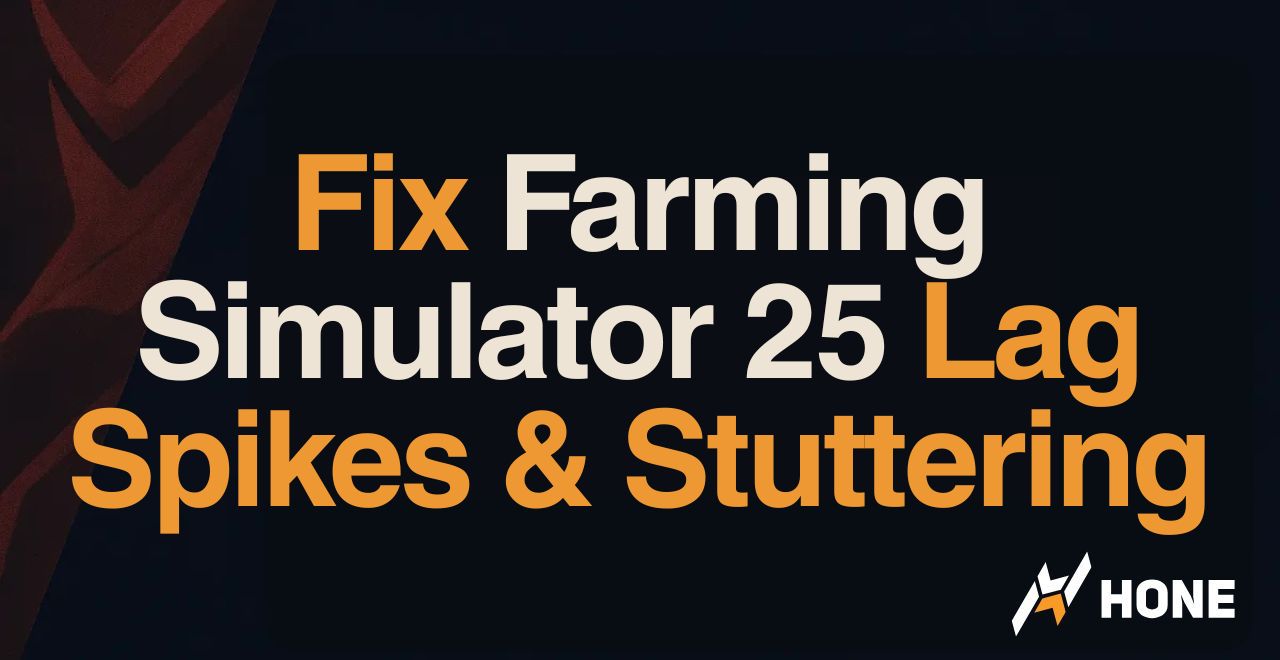That moment when your ping jumps from 30 to 300 and you’re frozen mid-teamfight? Yeah, we’re fixing that today. Lag spikes in League aren’t just annoying; they’re LP killers that turn winnable games into tilting disasters.
This guide zeroes in on eliminating network lag and those random ping spikes that make you look like you’re playing on McDonald’s WiFi. Whether it’s your ISP throttling your connection or your router having a seizure, we’ve got the fixes that actually work, tested and proven by players who went from 200ms slideshow to sub-50 butter.
Network Lag (Ping)
- High ping number (100ms+)
- Delayed ability casts
- Champions teleporting
- Skills going on cooldown without firing
- Movement commands delayed
Packet Loss
- Rubber-banding movement
- Actions not registering
- Sudden position changes
- Disconnection warnings
- Abilities disappearing mid-cast
Jitter (Unstable Ping)
- Ping jumping wildly (30→150→50)
- Inconsistent response times
- Smooth gameplay interrupted by spikes
- Hard to predict skill shots
- Worse during teamfights
Emergency Lag Fixes When You’re Already In-Game

Mid-game and suddenly lagging? Don’t panic. Here are the quickest fixes that can save your game without leaving the match. These take literally seconds and work more often than you’d think.
- Restart your router remotely – Most routers have apps now. Takes 60 seconds total.
- Alt+Tab and close everything – Especially Chrome, Discord overlay, Spotify
- Switch to Ethernet if on WiFi – Keep a cable near your setup for emergencies
- Type /mute all in chat – Reduces some network traffic from spam
- Windows Key + G → Disable Game Bar – Quick toggle if it’s capturing
- Flush DNS quickly – Win+R → cmd → “ipconfig /flushdns” → Enter
If nothing works: Tell your team you’re restarting client. It’s better to miss 2 minutes than int for 20.
Diagnose and Fix League of Legends Lag Problem in 2 Minutes
Before you start changing random settings, let’s figure out exactly what’s causing your lag. Different problems need different solutions, and guessing wastes time.
Quick Lag Diagnosis Tests
Windows: Press Win+R, type "cmd", press Enter
Then type these commands:
For NA: ping 104.160.131.3 -t
For EUW: ping 104.160.141.3 -t
For EUNE: ping 104.160.142.3 -t
For KR: ping 104.160.143.3 -t
Watch for 30 seconds. Look for:
- Average ping (should match in-game)
- "Request timed out" = packet loss
- Big variations = jitter problem
Press Ctrl+C to stop
In Command Prompt:
tracert 104.160.131.3 (or your server IP)
What to look for:
1. First 3 hops = Your home network (should be <5ms)
2. Next few hops = Your ISP (should be <30ms)
3. Later hops = Internet backbone
4. Last hops = Riot's network
If you see:
- Sudden jump in ms = That's where your problem is
- * * * (timeouts) = Potential packet loss point
- Same ISP name repeating with high ms = ISP issue
| Test Result | What It Means | Skip To Section |
|---|---|---|
| High ping on first hop (192.168.x.x) | Router/local network issue | Router Optimization |
| Normal ping but spikes every few seconds | WiFi interference or bandwidth competition | Router QoS Setup |
| Ping jumps at ISP hops | ISP routing or throttling | ISP Solutions |
| High ping all the way through | Distance to server or need VPN/GPN | VPN/GPN Setup |
| Packet loss (timeouts) | Connection quality issue | Cable/Hardware Check |
Router & Network Setup
Your router is the gatekeeper of your connection. A badly configured router can add 50ms+ to your ping and cause those rage-inducing spikes. Let's fix that.
Essential Router Optimizations
| Setting | What to Do | Why It Matters | Impact |
|---|---|---|---|
| Firmware Update | Login to router → Administration → Update | Fixes bugs, improves stability | HIGH |
| QoS for Gaming PC | Set your PC to highest priority by MAC address | Ensures League gets bandwidth first | HIGH |
| WiFi Channel | Use WiFi analyzer, pick least crowded (1, 6, or 11) | Reduces interference from neighbors | MEDIUM |
| DNS Settings | Change to 1.1.1.1 or 8.8.8.8 | Faster initial connections | LOW |
| UPnP | Enable for automatic port forwarding | Helps with connection stability | MEDIUM |
| Router Placement | Central, elevated, away from electronics | Better WiFi signal = less packet loss | MEDIUM |
Pro Tip: The Ethernet Gospel
I cannot stress this enough: USE ETHERNET. A $10 cable will solve 80% of lag issues. WiFi adds 5-50ms of latency and is vulnerable to:
- Microwave interference (yes, really)
- Neighbors' WiFi networks
- Walls and distance
- Random dropouts
If you absolutely can't run a cable, get a powerline adapter. It's not as good as direct Ethernet but leagues (pun intended) better than WiFi.
Port Forwarding for League of Legends
If UPnP isn't working or you want maximum connection stability, manual port forwarding can help. Here are the exact ports League uses:
| Port Range | Protocol | Purpose |
|---|---|---|
| 2099 | TCP | Game Client, Login |
| 5222-5223 | TCP | Chat Service |
| 8088 | TCP/UDP | Spectator Mode |
| 8393-8400 | TCP | Game Client, Patcher |
| 5000-5500 | UDP | Game Data (Most Important!) |
1. Find your PC's local IP:
- Win+R → cmd → ipconfig
- Look for "IPv4 Address" (usually 192.168.1.x)
2. Set static IP for your PC:
- Router settings → DHCP → Address Reservation
- Bind your PC's MAC address to that IP
3. Add port forwarding rules:
- Router settings → Port Forwarding
- Create rules for each port range above
- Point them to your PC's static IP
4. Windows Firewall exceptions:
- Add League of Legends to allowed apps
- Or create specific inbound/outbound rules
5. Test: Use canyouseeme.org to verify ports are open
When Your Internet Provider Is the Villain
Sometimes the problem isn't in your house; it's your ISP being shady. Here's how to catch them red-handed and fight back.
Detecting ISP Throttling
Signs Your ISP Is Throttling Gaming
- Time-based patterns: Lag only during peak hours (6-11 PM)
- Game-specific issues: League lags but YouTube works fine
- VPN magic: Using a VPN suddenly fixes your ping
- Speed test lies: Speed tests show full speed but games lag
- Sudden changes: Perfect connection until you hit a data cap
1. Play a game and note your ping/lag
2. Close League completely
3. Connect to a VPN (free trial works):
- Choose a server near you
- Not near the game server, near YOUR location
4. Launch League and play another game
5. Compare results:
If VPN ping is BETTER than normal:
→ Your ISP is 100% throttling game traffic
If VPN ping is WORSE (expected):
→ ISP probably isn't throttling
→ Look for other causes
How to Confront Your ISP
Calling ISP support sucks, but here's how to get results:
- Gather evidence first:
- Traceroute screenshots showing high latency at their hops
- Speed test results at different times
- Ping logs over 24 hours showing patterns
- VPN comparison if applicable
- Skip tier 1 support:
Say: "I need to speak with a network engineer about BGP routing issues affecting latency to Riot Games' servers."
- Use technical terms:
- "I'm experiencing high latency and packet loss at hop X"
- "The peering between your network and Riot's CDN appears congested"
- "TCP retransmissions are occurring at these specific times"
- Document everything:
- Record calls if legal in your area
- Get ticket numbers
- Email summaries after calls
- Nuclear option - File an FCC complaint:
If they won't help: consumercomplaints.fcc.gov
ISPs have 30 days to respond directly to you.
Advanced Network Tweaks for Minimum Latency in LoL
Ready to go deep? These Windows and network adapter tweaks can shave off those last few milliseconds. But beware; mess these up and you'll make things worse. One change at a time.
DNS Optimization Beyond Basics
While DNS doesn't affect in-game ping directly, a fast DNS improves initial connections and client responsiveness:
1. Windows Settings → Network & Internet → Change adapter options
2. Right-click your connection → Properties
3. Select "Internet Protocol Version 4" → Properties
4. Choose "Use the following DNS server addresses"
5. Enter your chosen DNS (e.g., 1.1.1.1 and 1.0.0.1). You can also see what DNS is best specifically for you at https://dnsspeedtest.online/
Then flush old DNS cache:
Win+R → cmd (as admin) → ipconfig /flushdns
Test new DNS:
nslookup leagueoflegends.com
TCP/IP Stack Optimization
Warning: Advanced Registry Edits
These changes modify core Windows networking. Create a system restore point first. If you're not comfortable with registry editing, skip this section.
| Tweak | What It Does | Command/Setting | Risk Level |
|---|---|---|---|
| Network Adapter Buffers | More buffer = less packet drops | Device Manager → Adapter → Receive/Transmit to max | LOW |
| Interrupt Moderation | Disable for lower latency at cost of CPU | Network adapter properties → Disabled | LOW |
| TCP Auto-Tuning | Keep at 'normal', but could test 'disabled' as it might help with bufferbloat | netsh int tcp set global autotuninglevel=normal | HIGH |
| RSS (Receive Side Scaling) | Spreads network load across CPU cores | netsh int tcp set global rss=enabled | LOW |
Network Adapter Advanced Settings
1. Device Manager → Network adapters → Your adapter → Properties → Advanced
Key settings to change:
Energy Efficient Ethernet: DISABLED
- Prevents adapter from sleeping
Flow Control: DISABLED
- Can cause micro-stutters
Interrupt Moderation: DISABLED
- Lower latency, higher CPU usage
Large Send Offload (IPv4): DISABLED
- Prevents packet bundling delays
Receive Buffers: 512 or higher
Transmit Buffers: 512 or higher
- More buffers = less packet loss
Power Management tab:
[ ] Allow computer to turn off this device
- Uncheck this!
VPNs, GPNs, and Routing Fixes

Sometimes your ISP's routing to Riot's servers is just garbage. That's where external routing solutions come in; they can literally reroute your connection through better paths.
Understanding GPNs vs VPNs for Gaming
| Feature | GPN (Gaming Private Network) | Standard VPN |
|---|---|---|
| Purpose | Optimize game routing specifically | Privacy, security, geo-unblocking |
| Encryption | Usually none (faster) | Full encryption (slower) |
| Traffic handled | Game traffic only | All system traffic |
| Latency impact | Can reduce ping if routing is bad | Usually increases ping |
| Best for | Bad ISP routing, high ping | ISP throttling, privacy |
| Examples | ExitLag, WTFast, NoPing | NordVPN, ExpressVPN |
When to Use Each Solution
Use a GPN when:
- Your ping is consistently high despite good internet
- Traceroute shows bad routing through your ISP
- You're far from game servers geographically
- You want to try different routes to the game server
Use a VPN when:
- Your ISP is throttling gaming traffic (proven by VPN test)
- You need to access different regions
- You're on public WiFi
- DDoS protection is a concern
Top Gaming Network Services Tested
| Service | Monthly Cost | Free Trial | Best For | Real User Results |
|---|---|---|---|---|
| ExitLag | $6.50 | 3 days | Multiple route options | Mixed: 0-20ms improvement typical |
| WTFast | $9.99 | 14 days | Automated optimization | YMMV: Great for some, useless for others |
| NoPing | $5.90 | 3 days | South American servers | Good for high ping regions |
| Mudfish | Pay per traffic (~$3) | Credit system | Budget option | Cheap but manual setup |
| NordVPN | $3-12 | 30-day refund | Throttling bypass | +10-30ms but fixes throttling |
1. Run traceroute to your game server (see earlier section)
2. Count the hops and note total latency
3. Download GPN free trial (ExitLag recommended to start)
4. Connect through GPN and run traceroute again
5. Compare:
Good result:
- Fewer hops (shorter route)
- Lower total latency
- More stable ping
Bad result:
- More hops (longer route)
- Same or higher latency
- Added instability
If bad: Cancel trial, try different GPN or accept your fate
If good: Consider if monthly cost worth the ms saved
The Complete League of Legends Lag Elimination Checklist

Work through this list systematically. Most players find their fix in the first half. Don't skip steps; the obvious stuff is obvious because it works.
Immediate Fixes (Do Right Now):
- ☐ Switch to Ethernet cable (seriously, just do it)
- ☐ Close all background apps (especially browsers)
- ☐ Restart router and modem (unplug 30 seconds)
- ☐ Run ping test to confirm it's network lag
- ☐ Disable Windows Game Bar and overlays
Router Configuration:
- ☐ Update router firmware
- ☐ Enable QoS for your gaming PC
- ☐ Change DNS to 1.1.1.1
- ☐ Enable UPnP or manually forward ports
- ☐ Switch WiFi to channel 1, 6, or 11
Windows Optimization:
- ☐ Update network adapter drivers
- ☐ Disable network adapter power saving
- ☐ Use the High Performance Windows power plan
- ☐ Disable unnecessary startup programs
- ☐ Run Windows network troubleshooter
Advanced Tweaks:
- ☐ Adjust network adapter buffers
- ☐ Test with VPN to check for throttling
- ☐ Run traceroute to find problem hops
- ☐ Consider GPN if routing is bad
Nuclear Options:
- ☐ Call ISP with traceroute evidence
- ☐ File FCC complaint if ISP won't help
- ☐ Switch ISPs if available
- ☐ Move closer to Chicago (NA server location)
Expectations vs Reality
Let's be real about what's possible. If you live in California and play on NA servers in Chicago, physics dictates you'll have at least 30-40ms ping. No amount of tweaking will get you to Korean PC bang levels of 5ms unless you literally move.
But here's what you CAN fix: those random spikes from 40 to 400ms, the packet loss that makes you moonwalk, the jitter that turns skillshots into slot machines. A stable 60ms is infinitely better than unstable 30ms.
Most lag isn't caused by one big problem; it's death by a thousand cuts. Your WiFi adds 10ms, your router's old firmware adds packet loss, Windows bloat adds another 5ms, your ISP's bad routing adds 20ms. Fix them all and suddenly you're playing a different game.
Now stop reading and go plug in that Ethernet cable. Your teammates are waiting.
FAQs
How to stop lag spikes in LoL?
Check your internet connection stability, use a wired connection, and close bandwidth-heavy apps. Lower graphics settings if FPS is dropping and update your drivers for better performance.
How do you fix extreme lag spikes?
Switch to a wired Ethernet connection, lower in-game graphics settings, and check for background updates or streaming apps. Also, ensure your router and drivers are updated.
How to fix FPS lag on League of Legends?
Lower graphics settings, update your GPU drivers, and close background apps. Enable “Low Spec Mode” and ensure your PC isn’t overheating to maintain steady FPS.
How to play LoL without lag?
Use a stable internet connection, lower graphics settings, and close unnecessary apps. Updating drivers and enabling “Low Spec Mode” can help reduce lag spikes and stuttering.






 Discord
Discord
 Instagram
Instagram
 Youtube
Youtube
 TikTok
TikTok